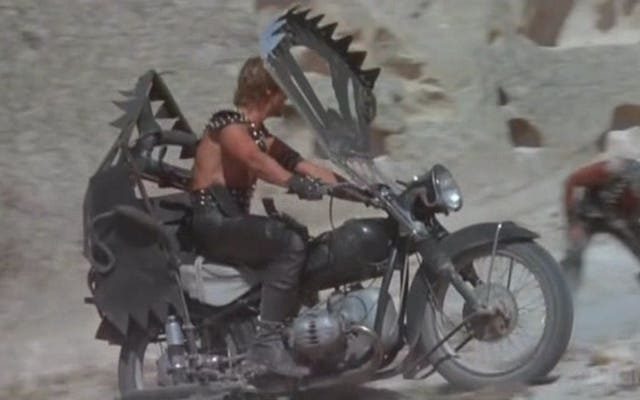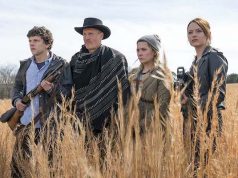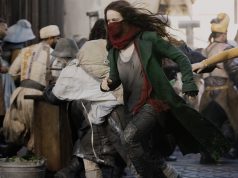
“Land of Doom” was made in the 1980s, which means there was a 35 percent chance it would take place in a post-apocalyptic future. This sort of movie was very common in the ’80s, partly because of Cold War fears of nuclear annihilation, and partly because movies set in barren wastelands don’t need a lot of expensive sets or costumes. Dress everybody in rags, find a patch of desert, and you’re good to go.
I have omitted details like “screenplay” and “actors” from that business model because so did the people who made “Land of Doom.” “What is our movie about?” the producers asked. “It’s about some people after the apocalypse!” the writer answered. “Can you be more specific?” asked the producers. “No I cannot!” said the writer. Then the director said, “Enough talk, time is money,” yelled “Action!,” and spent the next couple days pointing a camera at whoever walked in front of it.
The careless tone is set by the opening narration, in which a lady says: “I don’t know how the final war began. It doesn’t even matter.” Oh, doesn’t it? Pray tell, what else “doesn’t matter” in your movie? Plot? Characters? Inciting incidents, rising action, climax, and denouement? Yes, I thought so.
The lady who is uninterested in how the final war began is Harmony (Deborah Rennard), a feisty post-apocalyptic gal who just wants to roam the wastelands in peace and quiet without being hassled or murdered by anyone. You’d think it would be fairly easy to find solitude when the population of the entire planet can be expressed in five digits, but Harmony’s always running into marauders and gangs. (Maybe it’s because she keeps wandering through the same single acre of Turkish desert where the movie was filmed.)
One night while seeking refuge from the violent nightmare that society has become, she stumbles into a cave where a fellow named Anderson (Garrick Dowhen) is recuperating from wounds received in an earlier skirmish. In general, the post-apocalyptic men are even less sensitive toward women than the pre-apocalypse men were, but Anderson is decent. He’s too hurt to move, and they’re both stuck in the cave for the night.
“My name is Anderson. What’s yours?” (Silence.) “I just thought, since we’ll be spending the night together–”
“Will you shut up?”
“Whatever you say.”
Then he shoots a snake that was about to slither past her. (Note: Anderson has a gun.) (Also note: there is a zero-tolerance policy for snakes after the apocalypse.) This thoughtful, violent gesture softens her up.
“Harmony. My name is Harmony.”
“Oh. That’s a very pretty name.”
“What’s that supposed to mean?!”
So Harmony is not very easy to talk to.
Anderson is looking for a fabled land where peace has been restored. Perhaps Harmony would like to accompany him on his search for this place? Harmony says no: she is a loner.
“Most loners don’t survive.”
“I do.”
“I bet you do.”
OK, now it’s our turn: what’s that supposed to mean? Is “Land of Doom” going to be 85 minutes of two grumpy idiots talking to each other in vague but accusatory tones while nothing happens? Is this the passive-aggressive, post-apocalyptic version of “Who’s Afraid of Virginia Woolf?”? Because we do not have the strength for that.
Fortunately, there is more to it. The “villain” in this “story” (under certain limited definitions of those terms) is Slater (Daniel Radell), a blond lunatic who, in keeping with the tradition of insane costumes for villains in cheesy post-apocalyptic flicks, wears a leather “Phantom of the Opera” mask. Slater and Anderson used to be part of the same survivors’ community, but when it came time to organize and rebuild — which Anderson was a proponent of — he was outvoted in favor of anarchy and Slater-ism (which is easier and more fun than organizing and rebuilding). Now Slater is the leader of the most barbaric gang in the land, and his goons are constantly pursuing Anderson so they can kill him.
This, then, is the bulk of the film: Harmony and Anderson trudge endlessly through the desert; Harmony is increasingly grouchy at being dragged into Anderson’s problems; every few minutes a new batch of bedraggled Slater minions pops up; and Harmony and Anderson fight them hand-to-hand in sloppy, underrehearsed bouts choreographed by a crew member who had never seen a fight before.
You may ask: Why is Slater so intent on capturing Anderson? Anderson wants to get far, far away and find someplace nicer to live; why not let him? Did Anderson personally injury Slater in some unforgivable way? Is there more to it than a disagreement over leadership styles? I mean, the winners of elections don’t usually send death squads after the losers (though we’d probably have higher voter turnouts if they did). So what is driving Slater to be so passionate on this subject?
If you do ask yourself these questions, congratulations! You’ve given the story more thought than its writer did. Its writer got as far as “SLATER IS HUNTING ANDERSON” and then was distracted by something shiny.
Anyway, this goes on for a while, possibly forever. Harmony and Anderson meet a guy who offers them food that turns out to be human meat, which they decline like ungrateful bastards. Harmony continues to be angry about everyone and everything, even beating an attacker to death with a rock at one point. Anderson says, “Harmony, you can’t change the world by killing everybody,” which isn’t true, because killing everybody would actually be a very effective way of changing the world.
One thing I will say for “Land of Doom” is that the people in it, who are not good actors, are very enthusiastic about acting (which they are not good at). Nearly every performance, especially among the bad guys, is alive with over-the-top cackling lunacy. They don’t act well, but they act a lot. I could see the film being nominated for Most Acting.
— Film.com





